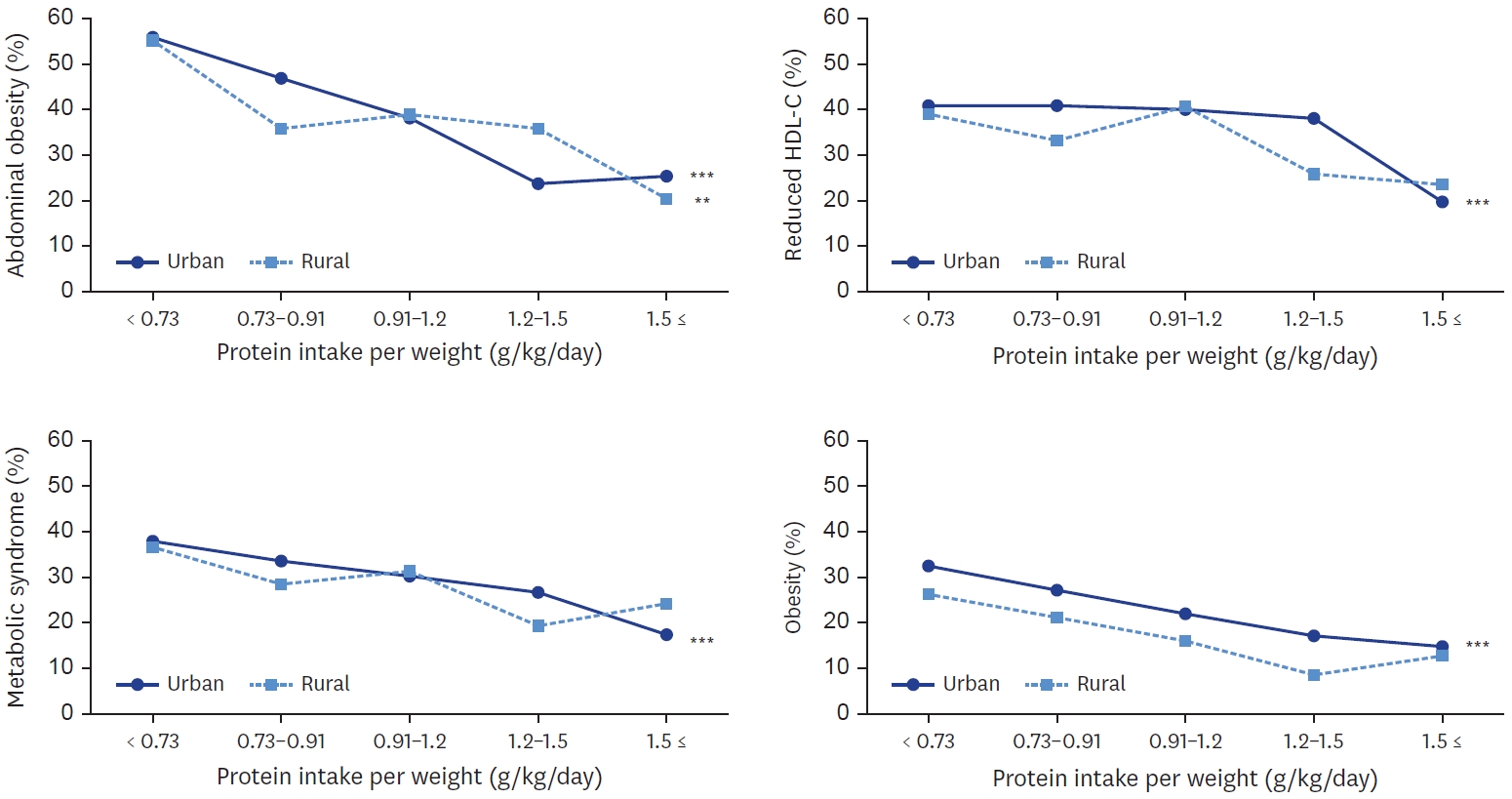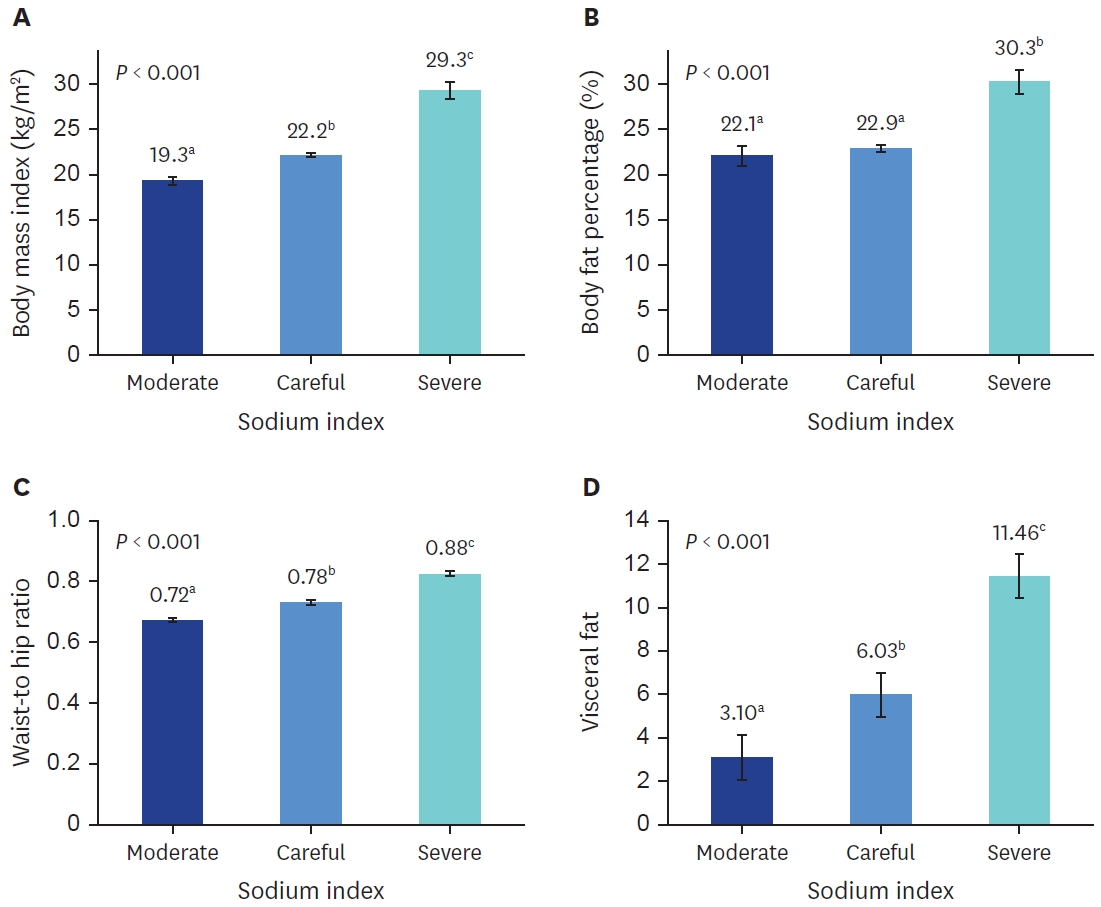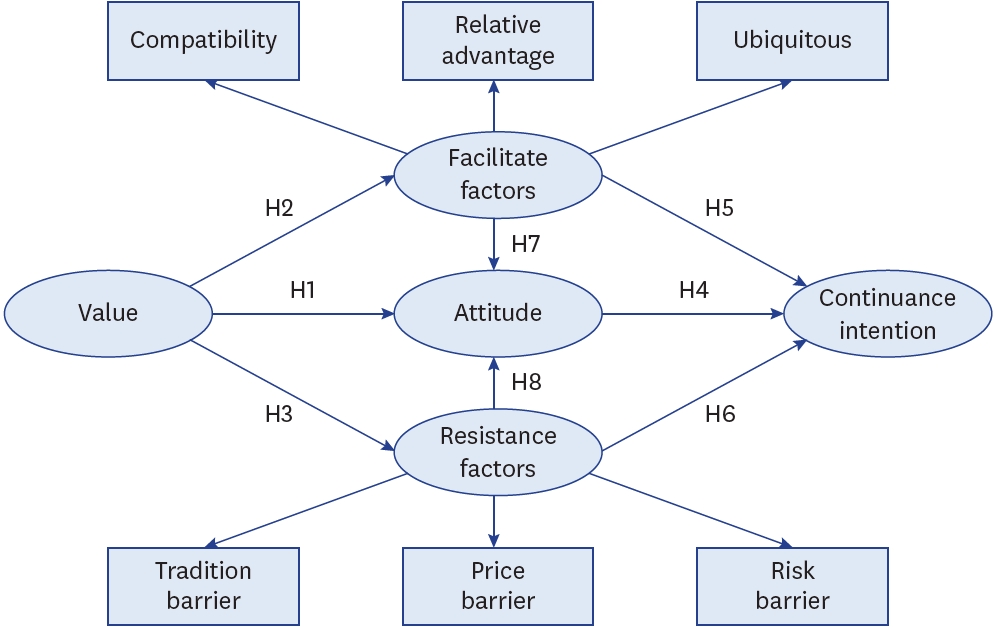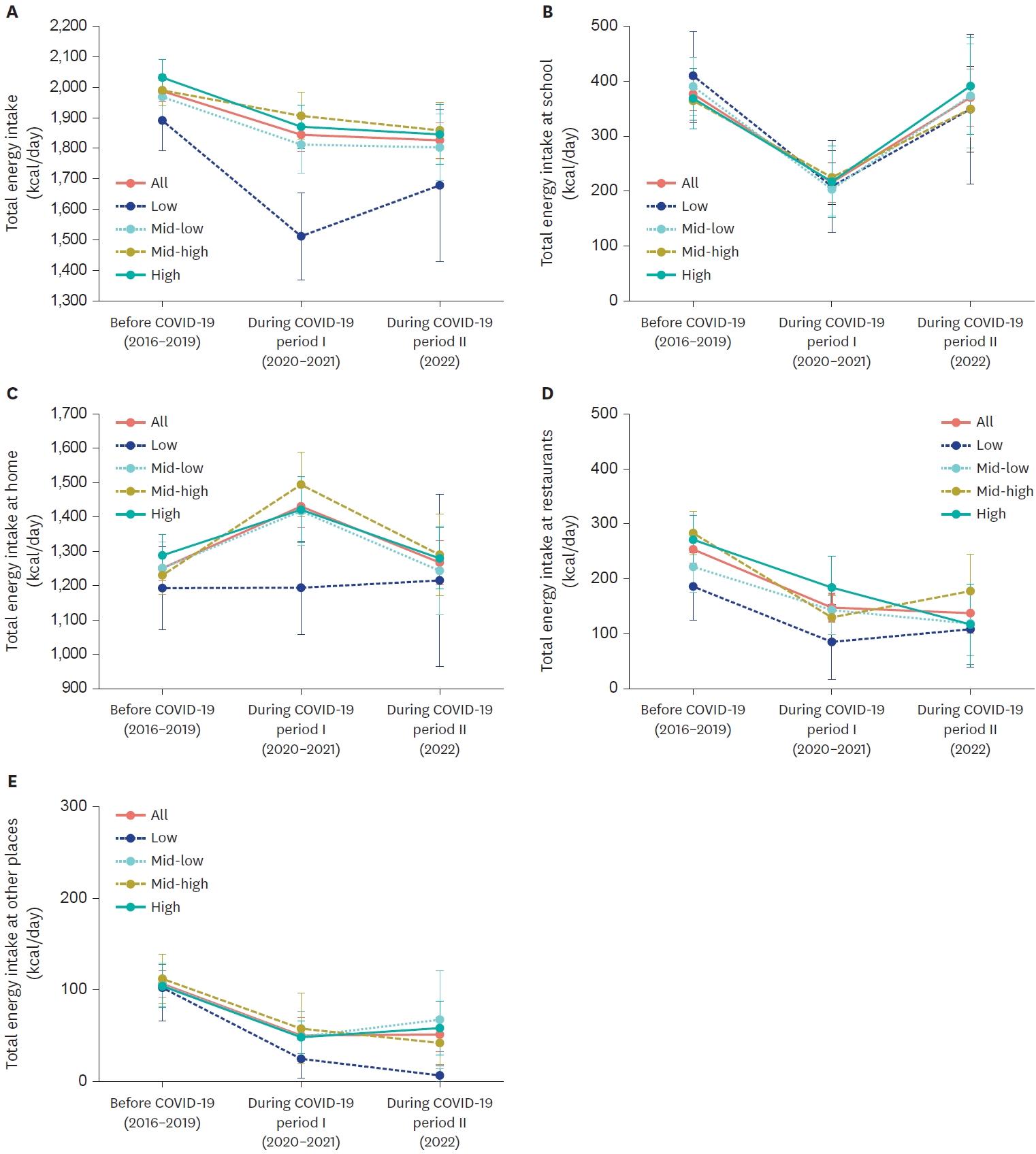Previous issues
- Page Path
- HOME > Browse Articles > Previous issues
Research Articles
- [English]
- Regional differences in protein intake and protein sources of Korean older adults and their association with metabolic syndrome using the 2016–2019 Korea National Health and Nutrition Examination Surveys: a cross-sectional study
- You-Sin Lee, Yoonna Lee
- Korean J Community Nutr 2024;29(3):173-188. Published online June 30, 2024
- DOI: https://doi.org/10.5720/kjcn.2024.29.3.173

-
 Abstract
Abstract
 PDF
PDF PubReader
PubReader ePub
ePub - Objectives
The study aim was to analyze the regional differences in dietary protein intake and protein sources of Korean older adults and their association with metabolic syndrome.
Methods
Study participants were 1,721 older adults aged 65 and over who participated in 2016–2019 Korea National Health and Nutrition Examination Survey. Using 24-hour recall dietary intake data, protein intake and their food sources were examined. The association between protein intake and metabolic syndrome, obesity, and abdominal obesity were analyzed by multiple logistic regression.
Results
Total protein and animal protein intakes were higher in urban area (60.0 g, 24.4 g, respectively) than in rural area (54.6 g, 19.6 g, respectively). With increase of protein intake level, animal to total protein proportion was increased in both areas. Total protein and plant protein intake was negatively associated with the risk of obesity, abdominal obesity in both areas. Animal protein intake was negatively associated with the risk of obesity in both areas, and with abdominal obesity only in urban area. In urban area, plant protein intake was also negatively associated with the risks of metabolic syndrome, elevated triglyceride, and reduced high density lipoprotein-cholesterol. In urban area, the risk of metabolic syndrome was decreased when their protein intake was more than 0.91 g/kg and was lowest when their protein intake was more than 1.5 g/kg (P for trend < 0.001).
Conclusions
Korean older adults showed inadequate protein intake and those in rural area showed lower animal protein intake than in urban area. The risk of obesity and metabolic syndrome was decreased with the increase of protein intake level. These findings may help develop effective nutrition support strategy for older adults to reduce regional health disparity.
- 4,764 View
- 79 Download

- [English]
- Relationship of sodium index with the obesity indicators of university students in Daegu, South Korea: a cross-sectional study
- Young-Won Jang, Jian Ma, Yeon-Kyung Lee
- Korean J Community Nutr 2024;29(3):189-198. Published online June 30, 2024
- DOI: https://doi.org/10.5720/kjcn.2024.29.3.189

-
 Abstract
Abstract
 PDF
PDF PubReader
PubReader ePub
ePub - Objectives
The sodium index is an index that converts the estimated sodium intake calculated using a verified and reliable sodium estimation formula. This study aimed to determine the relationship between the sodium index and obesity indicators and the potential impact of excessive sodium consumption on obesity.
Methods
Obesity indicators, such as body mass index (BMI), body fat percentage, waist-to-hip ratio (WHR), and visceral fat levels, were analyzed in 120 university students (60 men and 60 women). The sodium index was calculated by indexing the estimated sodium intake according to age, sex, BMI, salt-eating habits, and salt-eating behaviors. The relationship between sodium index and obesity indicators was analyzed using multiple logistic regression.
Results
The estimated sodium intake was 3,907.1 mg, with 76.7% of the participants categorized under the “careful” level of sodium index and 10.8% under the “moderate” level. As the sodium index increased, the BMI, body fat percentage, WHR, and visceral fat levels significantly increased. All obesity indicators significantly increased in patients with a “severe” sodium index than in those with a “moderate” sodium index. In addition, a strong positive correlation was identified between obesity indicators and sodium index. When the “severe” sodium index was compared with the “moderate” sodium index, the risk of obesity based on body fat percentage increased by 2.181 times (95% confidence interval [CI], 1.526–3.118), while the risk of obesity based on visceral fat level increased by 4.073 times (95% CI, 2.097–7.911).
Conclusions
Our findings suggest a correlation between excessive sodium intake and obesity. Moreover, the sodium index can be used to determine sodium intake.
- 2,357 View
- 32 Download

- [English]
- Factors influencing consumers’ continuance intention in online grocery shopping: a cross-sectional study using application behavior reasoning theory
- Binglin Liu, Min A Lee
- Korean J Community Nutr 2024;29(3):199-211. Published online June 30, 2024
- DOI: https://doi.org/10.5720/kjcn.2024.29.3.199

-
 Abstract
Abstract
 PDF
PDF PubReader
PubReader ePub
ePub - Objectives
Online grocery shopping has gained traction with the digital transformation of retail. This study constructs a behavioral model combining values, attitudes, and reasons for behavior—specifically, facilitators and resistance—to provide a more novel discussion and further understand the relative influences of the various factors affecting continuance intention in online grocery shopping.
Methods
Data were collected through an online questionnaire from consumers who had engaged in online grocery shopping during the past month in Seoul, Korea. All collected data were analyzed using descriptive analysis, and model validation was performed using partial least squares structural equation modeling.
Results
Continuance intention is primarily driven by facilitative factors (compatibility, relative advantage, and ubiquity). Attitude can also positively influence continuance intention. Although resistance factors (price, tradition, and risk) do not significantly affect continuance intention, they negatively affect attitude. Values significantly influence consumers’ reasoning processes but not their attitude.
Conclusions
These findings explain the key influences on consumers’ online grocery shopping behavior in Seoul and provide additional discussion and literature on consumer behavior and market management. To expand the online grocery market, consumers should be made aware of the potential benefits of the online channel; the barriers they encounter should be reduced. This will help sustain online grocery shopping behavior. Furthermore, its positive impact on attitude will further strengthen consumers’ continuance intention. -
Citations
Citations to this article as recorded by- Modelling the mass adoption potentials of fashion-augmented reality among the young consumers: evidence from an emerging economy
Mohima Akther, Mohammad Nurul Hassan Reza, Abdullah Al Mamun, Norzalita Abd Aziz, Marvello Yang
Journal of Fashion Marketing and Management: An International Journal.2025; 29(3): 459. CrossRef
- Modelling the mass adoption potentials of fashion-augmented reality among the young consumers: evidence from an emerging economy
- 4,768 View
- 72 Download
- 1 Crossref

- [English]
- Serum branch chain amino acids and aromatic amino acids ratio and metabolic risks in Koreans with normal-weight or obesity: a cross-sectional study
- Ji-Sook Park, Kainat Ahmed, Jung-Eun Yim
- Korean J Community Nutr 2024;29(3):212-221. Published online June 30, 2024
- DOI: https://doi.org/10.5720/kjcn.2024.29.3.212

-
 Abstract
Abstract
 PDF
PDF PubReader
PubReader ePub
ePub - Objectives
Metabolic disease is strongly associated with future insulin resistance, and its prevalence is increasing worldwide. Thus, identifying early biomarkers of metabolic-related disease based on serum profiling is useful to control future metabolic disease. Our study aimed to assess the association of serum branched chain amino acids (BCAAs) and aromatic amino acids (AAAs) ratio and metabolic disease according to body mass index (BMI) status among Korean adults.
Methods
This cross-sectional study included 78 adults aged 20–59 years in Korea. We compared serum amino acid (AA) levels between adults with normal-weight and adults with obesity and investigated biomarkers of metabolic disease. We examined serum AA levels, blood profile, and body composition. We also evaluated the association between serum AAs and metabolic-related disease.
Results
The height, weight, BMI, waist circumference, hip circumference, waist-hip-ratio, body fat mass, body fat percent, skeletal muscle mass, systolic blood pressure, and diastolic blood pressure were higher in the group with obesity compared to normal weight group. The group with obesity showed significantly higher levels of BCAA, AAA, and BCAA and AAA ratio. Further, BCAA and AAA ratio were significantly positively correlated with triglyceride, body weight, and skeletal muscle mass. The evaluation of metabolic disease risks revealed an association between the ratios of BCAAs and AAAs, hypertension, and metabolic syndrome.
Conclusions
Our study is showed the associations between BCAA and AAA ratio, obesity, and obesity-related diseases using various analytical approaches. The elevated BCAA and AAA ratio could be early biomarkers for predicting future metabolic diseases in Korean population. -
Citations
Citations to this article as recorded by- The Role of Aromatic Amino Acids in Polycystic Ovary Syndrome through Patients’ Blood Metabolic Profiling: A Systematic Review of the Past Five Years
Apostolos Gkantzos, Stavros Kalogiannis, Olga Deda
Journal of Proteome Research.2025; 24(5): 2208. CrossRef - Current Data on the Role of Amino Acids in the Management of Obesity in Children and Adolescents
Diana Zamosteanu, Nina Filip, Laura Mihaela Trandafir, Elena Ţarcă, Mihaela Pertea, Gabriela Bordeianu, Jana Bernic, Anne Marie Heredea, Elena Cojocaru
International Journal of Molecular Sciences.2025; 26(15): 7129. CrossRef
- The Role of Aromatic Amino Acids in Polycystic Ovary Syndrome through Patients’ Blood Metabolic Profiling: A Systematic Review of the Past Five Years
- 1,339 View
- 20 Download
- 2 Crossref

- [English]
- Total sugar intake and its contributed foods by age groups in Koreans using the 8th (2019–2021) Korea National Health and Nutrition Examination Survey: a cross-sectional study
- Hyejin Yu, Sang-Jin Chung
- Korean J Community Nutr 2024;29(3):222-233. Published online June 30, 2024
- DOI: https://doi.org/10.5720/kjcn.2024.29.3.222

-
 Abstract
Abstract
 PDF
PDF PubReader
PubReader ePub
ePub - Objectives
This study was conducted to investigate the status of total sugar intake and contributing foods in Korea according to age groups.
Methods
This study used 24-hour dietary recall data from the 8th Korea National Health and Nutrition Examination Survey (2019–2021) to investigate the nutritional and total sugar intake status among Koreans. A total of 18,338 research participants (≥3 years old) were included in this study. To analyze the types of foods contributing to total sugar intake, these foods were categorized into 15 types. Moreover, we examined the total sugar intake and ranked the most consumed foods by age groups (3–11 years, 12–18 years, 19–34 years, 35–49 years, 50–64 years, over 65 years). A survey procedure was employed for statistical analysis.
Results
The energy intake ratio from total sugars was approximately 12%–15%, which was within the recommended range. However, the proportion of individuals consuming total sugar exceeding 20% of their total caloric intake is nearly 20%, raising concerns about excessive sugar consumption. Furthermore, the percentage of participants whose intake of sugar from processed foods exceeded 10% of their total calories was highest in the 12–18 age group at 37.1%, followed by the 3–11 age group at 35.2%, and the 19–34 age group at 34.0%. Carbonated drinks, cola, and cider were the primary foods consumed by children and adolescents (3–18 years old) and young adults (19–34 years old). For middle-aged and older adults, mixed coffee with sugar and cream was a prominent contributor to sugar intake.
Conclusions
This study investigated sugar consumption patterns among Koreans, finding the principal foods contributing to this intake. Identifying these contributors is pivotal, given their potential impact on public health.
- 6,481 View
- 103 Download

- [Korean]
- Intake of energy and macronutrients according to household income among elementary, middle, and high school students before and during the COVID-19 pandemic: a cross-sectional study
- Chae-Eun Jeong, Heejin Lee, Jung Eun Lee
- Korean J Community Nutr 2024;29(3):234-252. Published online June 30, 2024
- DOI: https://doi.org/10.5720/kjcn.2024.29.3.234

-
 Abstract
Abstract
 PDF
PDF PubReader
PubReader ePub
ePub - Objectives
This study examined the intake of energy and macronutrients among elementary, middle, and high school students according to household income before the COVID-19 pandemic (2016–2019), during the social distancing period (2020–2021), and after the social distancing measures were lifted (2022).
Methods
We included 5,217 students aged 5–18 from the Korea National Health and Nutrition Examination Survey (KNHANES) conducted between 2016 and 2022. Dietary intake was assessed using one-day 24-hour dietary recalls. We estimated the least squares means (LS-means) of intake according to household income for each period using a weighted linear regression model, adjusted for age and sex. Differences in LS-means between the periods were analyzed using the t-test.
Results
During the social distancing period, the LS-means of energy intake among students decreased significantly by 143.2 kcal/day compared to pre-pandemic levels (P < 0.001). Students from low-income households experienced a more pronounced decrease in energy intake (−379.1 kcal/day, P < 0.001) and macronutrient intake compared to those from other income groups. Energy intake at school significantly declined for all income groups during the social distancing period compared to before the pandemic. No significant changes in home energy intake were observed among low-income students, whereas there was an increase for students from higher-income groups. Before the pandemic, 8.5% of students from low-income households reported insufficient food due to economic difficulties; this figure rose to 21.3% during the pandemic.
Conclusions
During the pandemic, students from low-income families experienced significantly lower intake of energy and macronutrients compared to pre-pandemic levels. The most substantial reductions were noted among low-income students, largely due to the lack of compensation for decreased school-based intake with increased intake at home. -
Citations
Citations to this article as recorded by- How Did the Dietary Behavior of Older Korean Adults Change During the COVID-19 Pandemic?
Yong-Seok Kwon, Dasol Kim, Hee-Sook Lim
Nutrients.2025; 17(12): 1973. CrossRef - Dietary Assessment of Older Korean Adults by Level of Plant Protein Intake
Yong-Seok Kwon, Ye-Jun Kim, Jeong-Hun Song, Yangsuk Kim
Nutrients.2025; 17(12): 1976. CrossRef - Changes in Ultra-Processed Food Consumption among Adolescents before and after the COVID-19 Pandemic : Using Data from the 7th (2018~2019) and 8th (2020~2021) Korea National Health and Nutrition Examination Survey
Hyun-Jin Hwang, Yoo Kyeong Kim
Korean Journal of Human Ecology.2024; 33(6): 981. CrossRef
- How Did the Dietary Behavior of Older Korean Adults Change During the COVID-19 Pandemic?
- 1,973 View
- 100 Download
- 3 Crossref


 KSCN
KSCN



 First
First Prev
Prev



